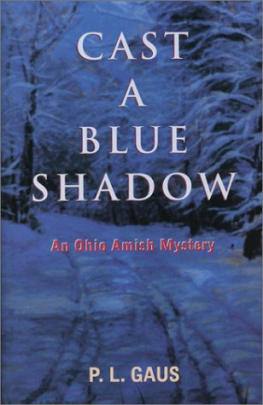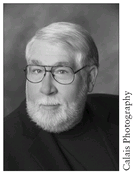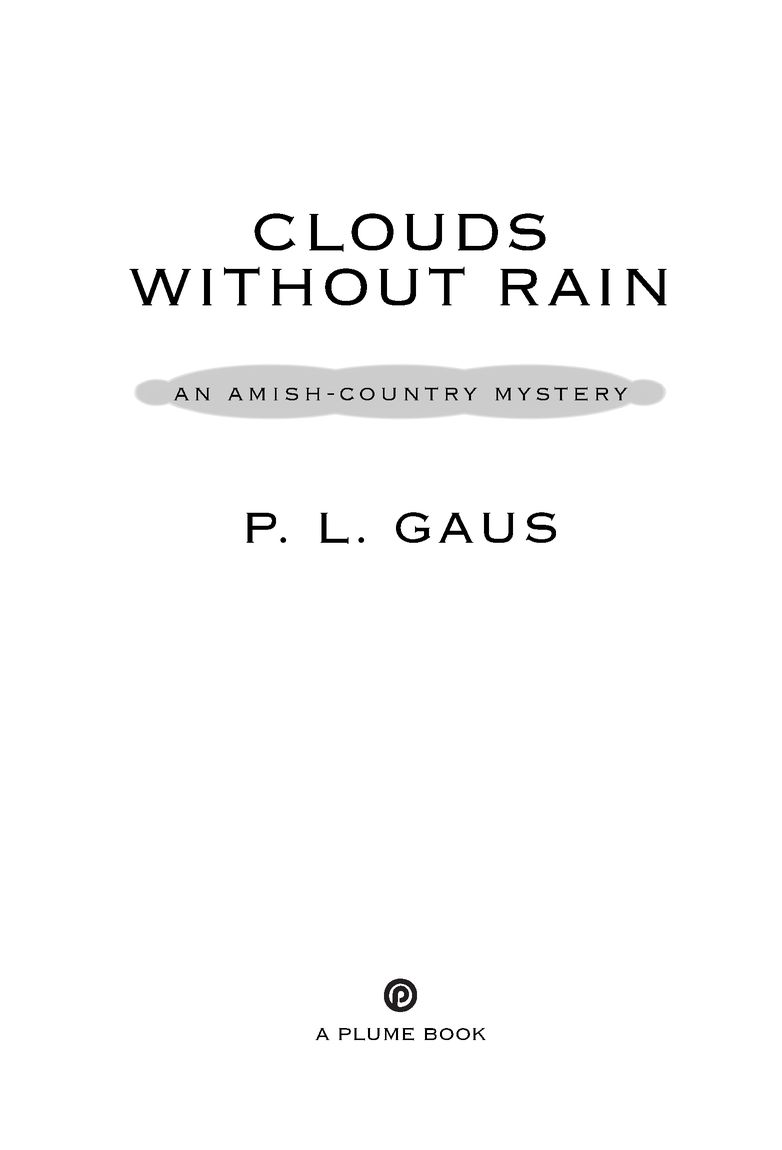Table of Contents
A PLUME BOOK
CLOUDS WITHOUT RAIN
PAUL LOUIS GAUS lives with his wife, Madonna, in Wooster, Ohio, just a few miles north of Holmes County, where the worlds largest and most varied settlement of Amish and Mennonite people is found. His knowledge of the culture of the Plain People stems from more than thirty years of extensive exploration of the narrow blacktop roads and lesser gravel lanes of this pastoral community, which includes several dozen sects of Anabaptists living closely among the so-called English or Yankee non-Amish people of the county. Paul lectures widely about the Amish people he has met and about the lifestyles, culture, and religion of this remarkable community of Christian pacifists. He can be found online at: www.plgaus.com. He also maintains a Web presence with Mystery Writers of America: www.mysterywriters.org.
Because of my wife, Madonna, and dedicated to our daughters, Laura and Amy
Jude 12
These men are blemishes at your love feasts, eating with you without the slightest qualmshepherds who feed only themselves. They are clouds without rain, blown along by the wind; autumn trees, without fruit and uprootedtwice dead.
Thursday, July 6, 2000
Associated Press
For the first time in at least 20 years, the average price of farmland in Ohio exceeds that of all the other Corn Belt states. The steady development of houses and shopping centers in rural Ohio eventually pushed the state into the top spot, an agricultural expert said yesterday. In the past, farmland was owned by farmers for agricultural purposes, said Allan Lines, an agricultural economist at Ohio State University. What were seeing now is we have all these other interests there in owning a piece of the real estate.
PREFACE AND ACKNOWLEDGMENTS
Not all of the places in this story are real, but all are as authentic to Holmes County, Ohio, as I know how to make them. Any resemblance to persons living or dead is purely coincidental, and any reference to legal and trust practices is my own fabrication, as are the events in this story. I have moved and altered the description of the psychiatric ward at Aultman Hospital. The ritual barn was located in Panther Hollow, not Walnut Creek Township. It has been destroyed.
Thanks go to the excellent staff at the burn unit in the Childrens Hospital Medical Center in Akron, Ohio, especially Julianne Klein, RN, BSN, and Mary Mondozzi, RN, MSN, as well as to Mark A. Harper of the Akron Fire Department, Ed Gasbarre of R. W. Gasbarre and Associates, Inc., surveyors, and Dr. Wayne M. Weaver of the Joel Pomerene Memorial Hospital in Millersburg.
Many thanks to Amish and former-Amish friends who do not wish to be named, and also to Chief Steve Thornton, Tom Kimmins, Esq., Ray and Kaye Fonte, Pastor Dean Troyer, and Eli Troyergood friends, able advisors.
Monday, August 7
4:15 P.M.
PROFESSOR Michael Branden, driving a black Amish buggy, worked his horse at a walk along Walnut Creek Township Lane T-414, just north of Indian Trail Creek in Holmes County, Ohio, on a sweltering Monday afternoon early in August. Coming up to one of the short stretches of blacktop laid in front of a house to cut the dust, he slowed the horse and rolled gently onto the pavement. The buggy rocked and swayed from side to side on its light oval springs, and the iron wheels cut sharp lines through the tar blisters in the blacktop. The horses hooves gave hollow plopping sounds that switched back to a lighter clicking in the dust and gravel after the blacktop played out beyond the house. The sky was cloudless, the sun hot, and beyond the thin line of trees that bordered the lane, the fields seemed withered and spent, the crops stricken with thirst.
Branden was dressed to outward appearance as an Amish-man. The Amish clothes and broad-brimmed straw hat with a flat crown were his own, bought two summers before, when he had worked on a kidnapping case involving an Amish child. He was wearing shiny blue denim trousers over leather work boots, a dark blue shirt with the sleeves rolled up to his elbows, and a black cloth vest, unfastened in front.
Under his vest, he had hooked a deputy sheriffs wallet badge over the belt he wore instead of the traditional suspenders, a concession to English style so that the heavy badge and three pairs of handcuffs would ride securely at his waist. The belt also held a beeper, though locating a phone in those parts of the county would be a task.
The professor brought the rig to a stop, took off his straw hat, poured a little water from a plastic bottle over his wavy brown hair, and rubbed at it vigorously. Then he laid his hat on the seat, and while he dried his tanned face and neck with a red bandanna, he straightened the rest of the gear riding beside him.
There was a black radio handset from the sheriffs department, turned off for the task at hand. A Holmes County map from the county engineers office, folded to the square of Walnut Creek Township. An elaborate Contax RTS III SLR camera with a long Zeiss lens, tucked securely into the corner of the buggy seat. On the floorboards under the seat, a Smith and Wesson Model 60 .357 Magnum revolver in a black leather holster.
With a light slap of the reins, Branden started the horse again. About a hundred yards further up the lane, he pulled into the drive of a new two-story Amish house and stepped the horse to a stone watering trough. A door on the upper floor opened as he stopped. Lydia Shetler, dressed in a plain, dark-blue dress and black bonnet, came out onto the top porch of the house and asked, Any luck, already? with the classic Dutch accent of the region.
The professor shook his head and said, Mind if I water the horse?
Lydia intoned, If it suits you, and leaned over with her elbows on the porch rail to watch.
The porch, braced with tall posts, was level with the second floor of the house. The area under this high porch was latticed in front with a rose arbor, which made a shady breezeway at ground level. The familys laundry was hung out for the day, drying on clotheslines in the breezeway.
Branden climbed out, and as the horse snorted and drank water, Lydia asked, How much longer do you figure to make these rides, yet, Herr Professor?
Till we get them, Branden said and laughed. He slapped his hat at the dust on his ankles and added, Or until the sheriff gets bored with the idea.
Lydia nodded as if to say that she understood the sheriffs impulsiveness well enough, and asked, Are you sure only our two families know about your business?
Why? Have you heard anything on the gossip mill?
Not a word.
Then I suppose Ill still keep riding. As long as nobody at either end lets it slip.
I havent heard any mention, Lydia repeated, and went back inside. Branden mounted into the buggy, swung around on the wide gravel lane, and walked his horse out to T-414 again, continuing east toward the little burg of Trail.
This was his fifth afternoon drive in two weeks, traveling the northern edges of Walnut Creek Township on the center-east edge of Holmes County. His assignment was to be the decoy in Sheriff Bruce Robertsons strategy to catch the two Amish-clad teenagers who were making a reputation for themselves that summer by robbing the Peaceful Ones. Disguised in rubber goats-head masks, they rode up to the slow-moving buggies on their mountain bikes and demanded money. Surprisingly large sums had been involved, and Sheriff Robertson now had his decoy in place. Professor Michael Branden, Civil War History, Millersburg College, a duly sworn reserve deputy, with a buggy, a costume of Amish clothes, a radio, an ample supply of handcuffs, and a very expensive camera. Also a revolver, just in case.











